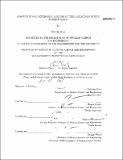Computational neutronics analysis of TRIGA reactors during power pulsing
Author(s)
Bean, Malcolm (Malcolm K.)
DownloadFull printable version (3.113Mb)
Alternative title
Computational neutronics analysis of Training, Research, Isotopes, General Atomics reactors during power pulsing
Other Contributors
Massachusetts Institute of Technology. Dept. of Mathematics.
Advisor
Benoit Forget.
Terms of use
Metadata
Show full item recordAbstract
Training, Research, Isotopes, General Atomics (TRIGA) reactors have the unique capability of generating high neutron flux environments with the removal of a transient control rod, creating conditions observed in fast fission reactors. Recently, several TRIGA reactors have had issues with the deformation of fuel rods nearest the transient control rod, where the neutron flux is highest. This is a difficult problem to analyze because the damage is not simply due to rods overheating, but rather the pressurization of hydrogen, from the Uranium Hydride fuel, that has diffused into the spacing between fuel and cladding. Previous neutronic analyses utilized point kinetics; a model which assumes changes in reactivity uniformly affect the reactor's flux, resulting in no relative spatial variation over time. Point kinetics is attractive because of its low computing costs, however the pulse's localization, theoretically, should generate a pronounced flux spike and radial neutron wave, which violates an assumption of point kinetics. The aim of the research is not to explicitly describe the cause of fuel rod deformation, but rather generate time dependent, high-resolution 3-dimensional flux maps. The Purdue Advance Reactor Core Simulator (PARCS) was used to simulate a TRIGA pulse with both nodal and point kinetics. Assuming our nodal kinetics models accurately simulate TRIGA pulses, we find that point kinetics methods are ill suited to simulate TRIGA pulses. By maintaining the steady-state flux profile, point kinetics does not capture the fact that the power peak actually occurs in the center assembly, from which the transient control rod is removed. In our simulations, point kinetics underestimated the normalize power in the central assembly by as much as 46.19%.
Description
Thesis (S.B.)--Massachusetts Institute of Technology, Dept. of Nuclear Science and Engineering; and, (S.B.)--Massachusetts Institute of Technology, Dept. of Mathematics, 2011. "May 2011." Cataloged from PDF version of thesis. Includes bibliographical references (p. 28).
Date issued
2011Department
Massachusetts Institute of Technology. Department of Mathematics; Massachusetts Institute of Technology. Department of Nuclear Science and EngineeringPublisher
Massachusetts Institute of Technology
Keywords
Nuclear Science and Engineering., Mathematics.